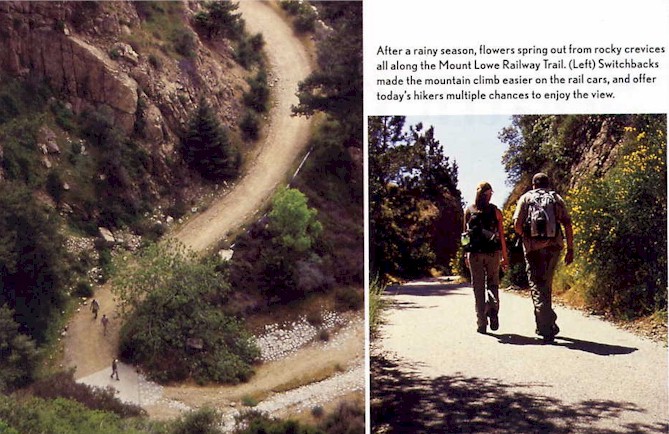![]()
 |
|
Mount Lowe Railway Trail
More than three million people from all over the world came here to experience a three-stage mountain adventure before the railway ended operation in 1937. After taking trolleys - the first stage - they transferred to cable cars for an ascent to the railway. This stage, known as the Great Cable Incline thanks to a 62 percent grade and 1,500-foot elevator gain over just 3,000 feet - employed technology similar to San Francisco's cable car system. The incline transported tourists to hotels and attractions atop Echo Mountain, where the railway's 3.5 mile alpine section began. Less precipitous than the Incline, this stretch offered its own thrills with open-air cars skirting around 127 curves. With the Incline long gone, it's now a nearly three-mile hike and 1,500 foot climb just to reach the alpine railway. The Sam Merrill Trail switchbacks up the mountain face hear the one-time incline, but I opt for the Sunset Ridge Trail, which instead runs above Millard Canyon. Although houses bump up against the base of the San Gabriel's maybe half a mile away, the trail is cut off from the city thanks to one of the canyon's steep walls. And remarkably in a metropolitan area of 15 million, I see just two other people - backpackers bound for Mount Lowe Campground - during hours of hiking. |
|
|
| After walking through forests thick with ferns and
the tangled vines of wild cucumber, I hear 50-foot Millard Falls plunging
into the canyon before catching a glimpse of the cascade from across the
chasm. In other sections, the slopes are more arid and brushy, covered
with such chaparral plants as chemise, laurel sumac and buckwheat.
Echo Mountain lives up to its name, as the call of a red-tailed hawk bounces around the canyon. The hotels, observatory and attractions succumbed long ago to fire and other disasters, but stone foundations and rusting machinery give a sense of just how ambitious Lowe's dream was. There's also a feeling of antiquity that I have experienced at other Southern California ruins. So much has changed so rapidly that a century here can feel like a millennium.
|
| Home Links
|